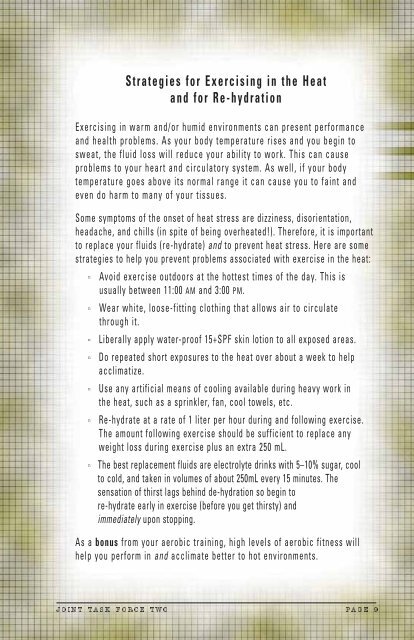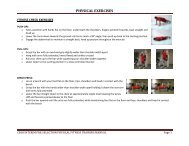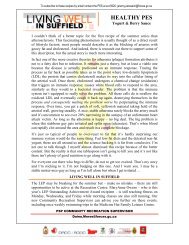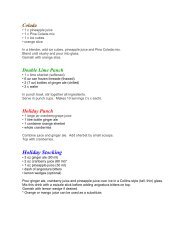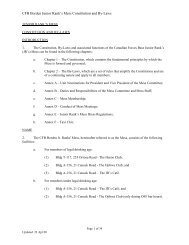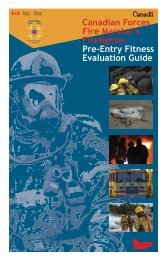Pre-selection physical fitness training program - Canadian Forces ...
Pre-selection physical fitness training program - Canadian Forces ...
Pre-selection physical fitness training program - Canadian Forces ...
Create successful ePaper yourself
Turn your PDF publications into a flip-book with our unique Google optimized e-Paper software.
Strategies for Exercising in the Heat<br />
and for Re-hydration<br />
Exercising in warm and/or humid environments can present performance<br />
and health problems. As your body temperature rises and you begin to<br />
sweat, the fluid loss will reduce your ability to work. This can cause<br />
problems to your heart and circulatory system. As well, if your body<br />
temperature goes above its normal range it can cause you to faint and<br />
even do harm to many of your tissues.<br />
Some symptoms of the onset of heat stress are dizziness, disorientation,<br />
headache, and chills (in spite of being overheated!). Therefore, it is important<br />
to replace your fluids (re-hydrate) and to prevent heat stress. Here are some<br />
strategies to help you prevent problems associated with exercise in the heat:<br />
n Avoid exercise outdoors at the hottest times of the day. This is<br />
usually between 11:00 AM and 3:00 PM.<br />
n Wear white, loose-fitting clothing that allows air to circulate<br />
through it.<br />
n Liberally apply water-proof 15+SPF skin lotion to all exposed areas.<br />
n Do repeated short exposures to the heat over about a week to help<br />
acclimatize.<br />
n Use any artificial means of cooling available during heavy work in<br />
the heat, such as a sprinkler, fan, cool towels, etc.<br />
n Re-hydrate at a rate of 1 liter per hour during and following exercise.<br />
The amount following exercise should be sufficient to replace any<br />
weight loss during exercise plus an extra 250 mL.<br />
n The best replacement fluids are electrolyte drinks with 5–10% sugar, cool<br />
to cold, and taken in volumes of about 250mL every 15 minutes. The<br />
sensation of thirst lags behind de-hydration so begin to<br />
re-hydrate early in exercise (before you get thirsty) and<br />
immediately upon stopping.<br />
As a bonus from your aerobic <strong>training</strong>, high levels of aerobic <strong>fitness</strong> will<br />
help you perform in and acclimate better to hot environments.<br />
JOINT TASK FORCE TWO PAGE 9


